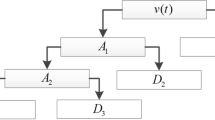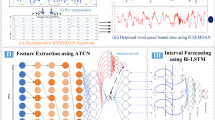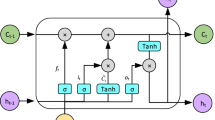Abstract
Accurate prediction of sea surface wind speed is crucial for marine activities such as marine search and rescue, marine shipping, and marine fishing. Because of the gustiness of sea surface winds, the wind speed data have strong non-stationarity and non-linearity, and it is still challenging to predict sea surface winds accurately and stably in a short time. Most previous studies have only considered the problem of non-smoothness of wind speed in single-point wind speed prediction, and this study extends the method to solve the non-smoothness of data in two dimensions. We proposed a hybrid model based on ensemble empirical mode decomposition (EEMD) and Convolutional long short-term memory network (ConvLSTM). Specifically, this study employs the Pearson correlation coefficient (PCC) to select the most periodic and most predictable subsequences of the EEMD signal decomposition, then fuse them into the spatio-temporal prediction of ConvLSTM. The method eliminates the influence of noise in the two-dimensional wind speed prediction and grasps the wind speed variation pattern more accurately. The proposed model has the best prediction effect based on the experimental findings, and this advantage becomes increasingly evident as time increases. This shows that EEMD signal decomposition is a good way to solve the short-term prediction problem for two-dimensional wind speed.












Similar content being viewed by others
Data Availability
The data used in this paper are publicly available and can be downloaded at https://cds.climate.copernicus.eu/cdsapp#!/dataset/reanalysis-era5-single-levels?tab=formdownload
References
Farjami H, Hesari ARE (2020) Assessment of sea surface wind field pattern over the caspian sea using eof analysis. Reg Stud Mar Sci 35:101254
Bu J, Yu K, Zuo X, Ni J, Li Y, Huang W (2023) Glows-net: A deep learning framework for retrieving global sea surface wind speed using spaceborne gnss-r data. Remote Sens 15(3):590
Zhang S, Yang X, Weng H, Zhang T, Tang R, Wang H, Su J (2023) Spatial distribution and trends of wind energy at various time scales over the south china sea. Atmosphere 14(2):362
Li A, Guan S, Mo D, Hou Y, Hong X, Liu Z (2020) Modeling wave effects on storm surge from different typhoon intensities and sizes in the south china sea. Estuar, Coast Shelf Sci 235:106551
Liu Z, Jiang P, Zhang L, Niu X (2020) A combined forecasting model for time series: Application to short-term wind speed forecasting. Appl Energy 259:114137
Zhang C, Ma H, Hua L, Sun W, Nazir MS, Peng T (2022) An evolutionary deep learning model based on tvfemd, improved sine cosine algorithm, cnn and bilstm for wind speed prediction. Energy 254:124250
Wang S, Cao J, Yu P (2020) Deep learning for spatio-temporal data mining: A survey. IEEE transactions on knowledge and data engineering
Alkhayat G, Mehmood R (2021) A review and taxonomy of wind and solar energy forecasting methods based on deep learning. Energy AI 4:100060
Wang Y, Zou R, Liu F, Zhang L, Liu Q (2021) A review of wind speed and wind power forecasting with deep neural networks. Appl Energy 304:117766
Gaidai O, Xing Y, Xu X (2023) Novel methods for coupled prediction of extreme wind speeds and wave heights. Sci Rep 13(1):1119
Xian H, Che J (2022) Unified whale optimization algorithm based multikernel svr ensemble learning for wind speed forecasting. Appl Soft Comput 130:109690
Liu M, Cao Z, Zhang J, Wang L, Huang C, Luo X (2020) Shortterm wind speed forecasting based on the jaya-svm model. Int J Electr Power Energy Syst 121:106056
Lahouar A, Slama JBH (2017) Hour-ahead wind power forecast based on random forests. Renew Energy 109:529–541
Liu X, Lin Z, Feng Z (2021) Short-term offshore wind speed forecast by seasonal arima-a comparison against gru and lstm. Energy 227:120492
Schultz MG, Betancourt C, Gong B, Kleinert F, Langguth M, Leufen LH, Mozaffari A, Stadtler S (2021) Can deep learning beat numerical weather prediction? Phil Trans R Soc A 379(2194):20200097
Ubaid AM, Dweiri FT, Ojiako U (2020) Organizational excellence methodologies (oems): a systematic literature review. Int J Syst Assur Eng Manag 11:1395–1432
Alrae R, Nasir Q, Abu Talib M (2020) Developing house of information quality framework for iot systems. Int J Syst Assur Eng Manag 11:1294–1313
Alketbi A, Nasir Q, Abu Talib M (2020) Novel blockchain reference model for government services: Dubai government case study. Int J Syst Assur Eng Manag 11:1170–1191
Bera S, Gupta GS, Kumar D, Shiva Kumar S, Gupta KK (2023) Lstm-ukf framework for an effective global land-ocean index temperature prediction. Journal of Ambient Intelligence and Humanized Computing 14(3):2369–2384
Son Y, Zhang X, Yoon Y, Cho J, Choi S (2022) Lstm-gan based cloud movement prediction in satellite images for pv forecast. Journal of Ambient Intelligence and Humanized Computing 1–14
Zeng L, Zhang H, Han Q, Tang Y, Ye L, Wu Y, Zu H (2021) An lstmbased driving operation suggestion method for riding comfort-oriented critical zone. Journal of Ambient Intelligence and Humanized Computing 1–17
Zhang Z, Wang Z (2021) Design of financial big data audit model based on artificial neural network. International Journal of System Assurance Engineering and Management 1–10
Joseph LP, Deo RC, Prasad R, Salcedo-Sanz S, Raj N, Soar J (2023) Near real-time wind speed forecast model with bidirectional lstm networks. Renew Energy 204:39–58
Deng X, Shao H, Hu C, Jiang D, Jiang Y (2020) Wind power forecasting methods based on deep learning: A survey. Comput Model Eng Sci 122(1):273
Shahid F, Zameer A, Muneeb M (2021) A novel genetic lstm model for wind power forecast. Energy 223:120069
Han L, Zhang R, Wang X, Bao A, Jing H (2019) Multi-step wind power forecast based on vmd-lstm. IET Renewable Power Generation 13(10):1690–1700
Jaseena K, Kovoor BC (2021) Decomposition-based hybrid wind speed forecasting model using deep bidirectional lstm networks. Energy Convers Manag 234:113944
Li C, Tang G, Xue X, Saeed A, Hu X (2019) Short-term wind speed interval prediction based on ensemble gru model. IEEE Trans Sustain Energy 11(3):1370–1380
Wang Y, Gui R (2022) A hybrid model for gru ultra-short-term wind speed prediction based on tsfresh and sparse pca. Energies 15(20):7567
Hu T, Wu W, Guo Q, Sun H, Shi L, Shen X (2019) Very short-term spatial and temporal wind power forecasting: A deep learning approach. CSEE Journal of Power and Energy Systems 6(2):434–443
He B, Ye L, Pei M, Lu P, Dai B, Li Z, Wang K (2022) A combined model for short-term wind power forecasting based on the analysis of numerical weather prediction data. Energy Rep 8:929–939
Chen Y, Wang Y, Dong Z, Su J, Han Z, Zhou D, Zhao Y, Bao Y (2021) 2-d regional short-term wind speed forecast based on cnn-lstm deep learning model. Energy Convers Manag 244:114451
Wu Q, Guan F, Lv C, Huang Y (2021) Ultra-short-term multi-step wind power forecasting based on cnn-lstm. IET Renewable Power Generation 15(5):1019–1029
Yan Y, Wang X, Ren F, Shao Z, Tian C (2022) Wind speed prediction using a hybrid model of eemd and lstm considering seasonal features. Energy Rep 8:8965–8980
Wu H, Meng K, Fan D, Zhang Z, Liu Q (2022) Multistep short-term wind speed forecasting using transformer. Energy 261:125231
Memarzadeh G, Keynia F (2020) A new short-term wind speed forecasting method based on fine-tuned lstm neural network and optimal input sets. Energy Convers Manag 213:112824
Han Y, Mi L, Shen L, Cai C, Liu Y, Li K, Xu G (2022) A shortterm wind speed prediction method utilizing novel hybrid deep learning algorithms to correct numerical weather forecasting. Appl Energy 312:118777
Saxena BK, Mishra S, Rao KVS (2021) Offshore wind speed forecasting at different heights by using ensemble empirical mode decomposition and deep learning models. Appl Ocean Res 117:102937
Ren Y, Li Z, Xu L, Yu J (2023) The data-based adaptive graph learning network for analysis and prediction of offshore wind speed. Energy 126590
(C3S), CCCS (2017) Era5: Fifth generation of ecmwf atmospheric reanalyses of the global climate. Copernicus climate change Service climate data store (CDS) 15(2):2020
Mahmoodi K, Ghassemi H, Razminia A (2019) Temporal and spatial characteristics of wave energy in the persian gulf based on the era5 reanalysis dataset. Energy 187:115991
Ramon J, Lledó L, Torralba V, Soret A, Doblas-Reyes FJ (2019) What global reanalysis best represents near-surface winds? Quarterly Journal of the Royal Meteorological Society 145(724):3236–3251
Yan Z, Wang Z, Pang L (2022) Study of the wind conditions in the south china sea and its adjacent sea area. J Ocean Univ China 21(2):264–276
Kok PH, Wijeratne S, Akhir MF, Pattiaratchi C, Roseli NH, Mohamad Ali FS (2021) Interconnection between the southern south china sea and the java sea through the karimata strait. J Mar Sci Eng 9(10):1040
Lei Y, He Z, Zi Y (2009) Application of the eemd method to rotor fault diagnosis of rotating machinery. Mechanical Systems and Signal Processing 23(4):1327–1338
Wu Z, Huang NE (2009) Ensemble empirical mode decomposition: a noiseassisted data analysis method. Adv Adapt Data Anal 1(01):1–41
Meng F, Xu D, Song T (2022) Atdnns: An adaptive time-frequency decomposition neural network-based system for tropical cyclone wave height real-time forecasting. Futur Gener Comput Syst 133:297–306
Hochreiter S, Schmidhuber J (1997) Long short-term memory. Neural Comput 9(8):1735–1780
Sun Z, Zhao M (2020) Short-term wind power forecasting based on vmd decomposition, convlstm networks and error analysis. IEEE Access 8:134422–134434
Shi X, Chen Z, Wang H, Yeung D-Y, Wong W-K, Woo W-C (2015) Convolutional lstm network: A machine learning approach for precipitation nowcasting. Adv Neural Inf Process Syst 28
Barhmi S, Elfatni O, Belhaj I (2020) Forecasting of wind speed using multiple linear regression and artificial neural networks. Energy Syst 11:935–946
Bloemendaal N, De Moel H, Muis S, Haigh ID, Aerts JC (2020) Estimation of global tropical cyclone wind speed probabilities using the storm dataset. Sci Data 7(1):377
Wang D, Dong Z, Jiang F, Zhu S, Ling Z, Ma J (2022) Spatiotemporal variability of drought/flood and its teleconnection with large-scale climate indices based on standard precipitation index: a case study of taihu basin, china. Environ Sci Pollut Res 29(33):50117–50134
Amato F, Guignard F, Robert S, Kanevski M (2020) A novel framework for spatio-temporal prediction of environmental data using deep learning. Sci Rep 10(1):22243
Hong DTB, Vinh TQ (2022) Probabilistic simulations for seasonal typhoon genesis over the south china sea. Earth Syst Environ 6(4):903–916
Shao Q, Hou G, Li W, Han G, Liang K, Bai Y (2021) Ocean reanalysis data-driven deep learning forecast for sea surface multivariate in the south china sea. Earth Space Sci 8(7):2020–001558
Song T, Han R, Meng F, Wang J, Wei W, Peng S (2022) A significant wave height prediction method based on deep learning combining the correlation between wind and wind waves. Front Mar Sci 1931
Acknowledgements
We thank Zhiyuan Zhang and Xin Li for their valuable comments on the article, which helped us to further understand the limitations of this paper and the direction of future work.
Author information
Authors and Affiliations
Corresponding authors
Ethics declarations
Conflict of interests
The authors have no relevant financial or non-financial interests to disclose.
Additional information
Publisher's Note
Springer Nature remains neutral with regard to jurisdictional claims in published maps and institutional affiliations.
Rights and permissions
Springer Nature or its licensor (e.g. a society or other partner) holds exclusive rights to this article under a publishing agreement with the author(s) or other rightsholder(s); author self-archiving of the accepted manuscript version of this article is solely governed by the terms of such publishing agreement and applicable law.
About this article
Cite this article
Sun, H., Song, T., Li, Y. et al. EEMD-ConvLSTM: a model for short-term prediction of two-dimensional wind speed in the South China Sea. Appl Intell 53, 30186–30202 (2023). https://doi.org/10.1007/s10489-023-05042-0
Accepted:
Published:
Issue Date:
DOI: https://doi.org/10.1007/s10489-023-05042-0




